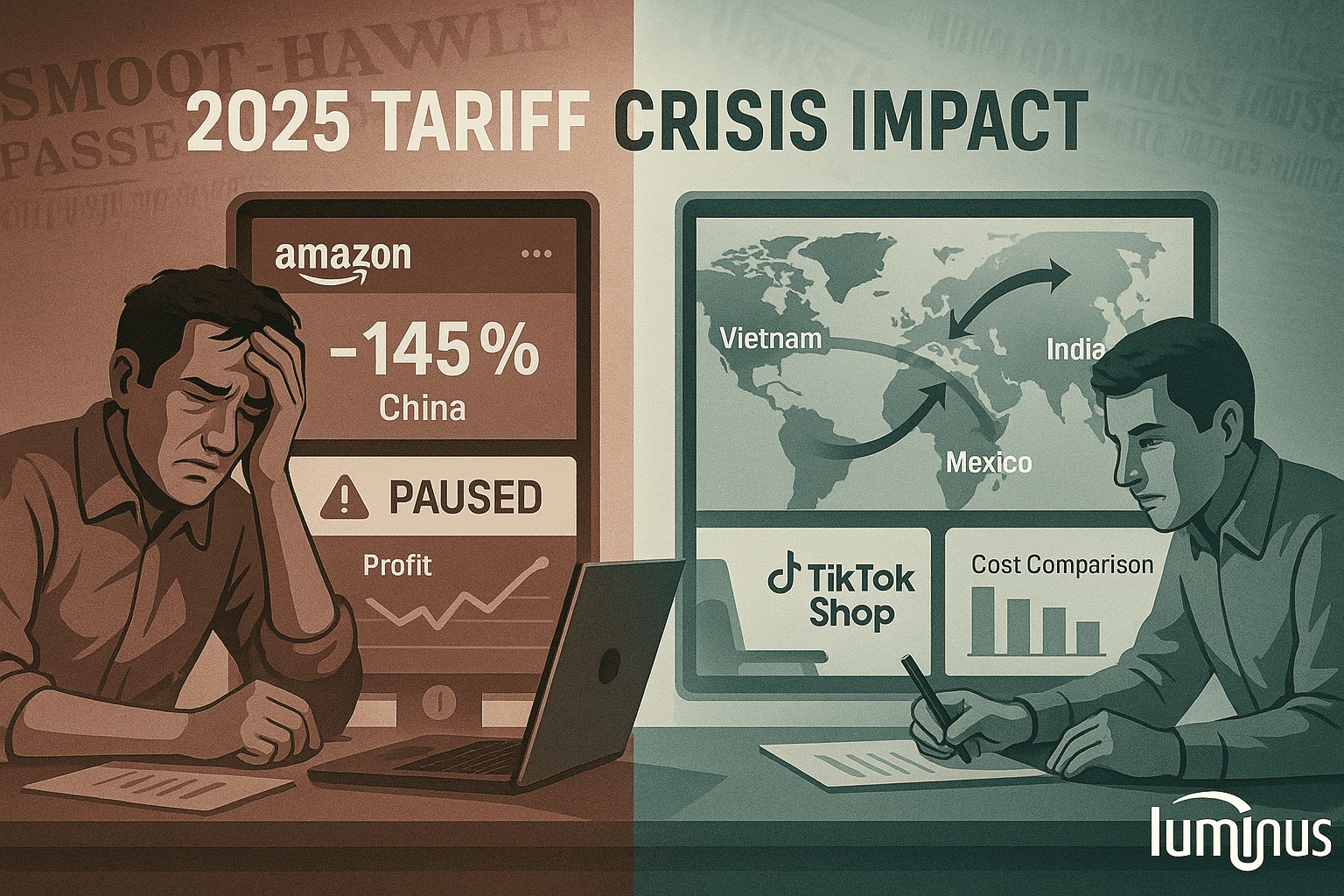Understanding the Historic Economic Disruption Facing E-Commerce Businesses in 2025
The reality we’re witnessing in our portfolio of Amazon seller clients is sobering. Some have paused operations entirely. Others are in active restructuring mode, desperately pivoting supply chains and renegotiating with suppliers. A fortunate few aren’t being hit by Trump’s tariffs due to domestic sourcing or favorable country exemptions. But these aren’t failing businesses—these are profitable, well-run operations facing an unprecedented economic scenario that’s forcing impossible choices.
The numbers tell a stark story. President Trump’s tariffs have raised the average U.S. tariff rate from 2.5% in January 2025 to estimates ranging from the high-teens to low-twenties by mid-year—briefly peaking higher in April—marking the highest sustained levels since the Great Depression. For context, that’s approaching rates not seen since the infamous Smoot-Hawley era of 1930.
Historical Context: We’ve Been Here Before
The highest tariffs in modern U.S. history were imposed by the United States on itself through the Smoot-Hawley Tariff Act, signed into law on June 17, 1930. This legislation raised tariffs on over 20,000 imported goods, with rates averaging 40-60% and reaching as high as 59.1% on dutiable imports.
Back then, more than 1,000 economists signed a petition imploring President Herbert Hoover to veto the tariff. He ignored them. The result? Global trade fell by 66% between 1929 and 1934. Unemployment in the U.S. jumped from 8% in 1930 to 25% by 1932-1933. The tariffs didn’t cause the Great Depression, but economic historians widely agree they deepened and prolonged it.
Here’s the critical detail most people miss: The Smoot-Hawley tariffs didn’t survive long in their extreme form. By 1934—just four years later—President Franklin D. Roosevelt signed the Reciprocal Trade Agreements Act, which began systematically reducing tariff levels and promoting trade liberalization. The political backlash was swift: Senator Reed Smoot and Representative Willis Hawley both lost their seats in the 1932 elections, and voters made clear their disdain for protectionist policies.
The lesson? Extreme tariff regimes historically collapse under their own weight, typically within 2-4 years, as economic pain becomes politically untenable.
Trump’s 2025 Tariff Schedule: The Current Reality
As of October 2025, here’s what Amazon sellers are actually facing:
By Country Tariff Rates:
China: Combined rates reported as high as ~145% at points in 2025
- Multiple tariff layers including “fentanyl” duties, baseline tariffs, and reciprocal rates
- Rates have shifted amid pauses, exemptions, and ongoing litigation
- Exact breakdown varies by product category and time period
Mexico: 25% on non-USMCA compliant goods
- USMCA-compliant products remain exempt
- Subject to 90-day negotiation windows and suspensions
Canada: 25-35% on non-USMCA compliant goods
- 10% on energy and potash
- Higher rates on non-compliant imports
- USMCA-compliant products exempt
European Union: Announced rates of 20-30%
- Subject to ongoing negotiations
- Evolving terms throughout 2025
Vietnam: Announced reciprocal tariff of 46%
Thailand: Announced reciprocal tariff of 36%
Japan: Announced rate of 24% (paused during negotiations)
Baseline: 10% minimum on most imports
- Exceptions for semiconductors, certain minerals, copper (cathode), smartphones, computers, and electronic parts
- Many rates subject to 90-day pauses starting April 9 for negotiating partners
What Makes 2025 Different
Unlike Smoot-Hawley’s relatively uniform approach, Trump’s 2025 tariffs are:
- Country-specific with rates calculated based on trade deficits
- Rapidly changing with frequent pauses, modifications, and exemptions
- Legally contested (Court of International Trade ruled them illegal; currently stayed pending Supreme Court review)
- Selectively enforced with direct presidential intervention in individual company cases
Insights & Updates for Smart Amazon Sellers
The Economic Impact: What the Data Shows
The numbers from verified sources paint a clear picture of economic disruption:
Import Costs:
- A $1,000 product from China can now cost $2,450-$2,720 landed (depending on specific tariff combination) before FBA fees or storage
- Monthly tariff revenue has increased substantially from under $10 billion in 2024
- Tax Foundation estimates tariff costs of $800-$1,200+ per household over 2025-2034, though models vary
Market Response:
- S&P 500 fell approximately 4.88% on April 2’s “Liberation Day” announcement—one of the sharpest single-day drops of 2025
- Nasdaq Composite experienced severe losses in the 5-6% range
- Continued market volatility throughout spring and summer 2025
Business Impact:
- 25% of Amazon price increases come from China-based sellers
- 60% of Amazon’s Black Friday sales came from individual sellers, many now struggling
- Amazon took a $1 billion hit in Q2 2025 linked to tariffs and customer returns
Trump’s Statements on Tariffs
President Trump has been consistent and unapologetic about his tariff policy:
“Tariff is the most beautiful word in the dictionary.” – Donald Trump, repeated statement
On “Liberation Day” (April 2, 2025): “April 2, 2025, will forever be remembered as the day American industry was reborn, the day America’s destiny was reclaimed.”
On Amazon displaying tariff costs (April 29, 2025): After calling Jeff Bezos directly, Trump said: “Jeff Bezos was very nice. He was terrific. He solved the problem very quickly. Good guy.”
The White House, through Press Secretary Karoline Leavitt, called Amazon’s plan to display tariff costs next to product prices “a hostile and political act.”
On the 90-day pause (April 9, 2025): Trump paused higher reciprocal tariffs for 75 countries while maintaining them on China, stating deals were being negotiated.
Jeff Bezos and Amazon’s Position
Jeff Bezos has notably shifted his public stance on Trump since the 2024 election:
December 2024: Bezos expressed optimism about Trump’s second term, saying he believes Trump “has grown calmer and more confident.”
Actions speak louder:
- Amazon donated $1 million to Trump’s inaugural fund
- Bezos attended Trump’s inauguration
- Amazon is producing a documentary focused on First Lady Melania Trump
The Tariff Display Incident (April 29, 2025):
When reports emerged that Amazon would display tariff costs next to product prices, Trump personally called Bezos to complain. Within hours, Amazon publicly downplayed and then scrapped the plan entirely.
Trump later praised Bezos: “He’s 100 percent. He’s been great.” – Trump to The Atlantic, April 2025
The reality beneath the cordial relationship: Amazon’s business faces substantial pressure from the tariff regime. According to various reports, a significant portion of Amazon’s goods are sourced from China, making the company exceptionally vulnerable to the elevated China tariffs.
What This Means for Amazon Sellers Right Now
The parallels to 1930 are impossible to ignore. Just like Smoot-Hawley, we’re seeing extreme tariff rates disrupting global trade, immediate retaliation from trading partners, market volatility, and mounting political pressure as economic pain spreads.
But here’s the critical difference: You can’t wait this out.
The Immediate Reality
Supply Chain Crisis: Sellers are frantically seeking suppliers in Vietnam, India, Mexico, and other lower-tariff countries. But switching isn’t simple—it takes 3-6 months minimum to vet new suppliers, test quality, and establish reliable shipping.
Inventory Nightmare: Many sellers are reducing inventory levels to minimize tariff exposure, accepting stockout risks rather than paying 145% duties on goods that might sit for months.
The Pricing Death Trap: You face an impossible choice: absorb costs and destroy margins, or raise prices and lose the Buy Box to competitors who haven’t adjusted yet.
Business Model Shifts: Some sellers are exiting physical products entirely, focusing on digital products, services, or pivoting to TikTok Shop and Instagram Shopping where they have more pricing flexibility.
How Long Will This Last?
History suggests extreme tariff regimes are unsustainable. Smoot-Hawley’s most punitive provisions lasted approximately 4 years before reversal. Current indicators suggest similar timeline:
- Political backlash building (73% of Americans expect price surges, 57% oppose tariffs)
- Market punishment continuing (ongoing volatility)
- Legal challenges advancing (Supreme Court hearing November 5, 2025)
- International pressure mounting
But 4 years might as well be forever if your business runs out of cash in 6 months.
Survival Strategies: What’s Actually Working
1. Geographic Diversification
- Move sourcing to Vietnam (announced 46% tariff vs. China’s higher rates, though subject to negotiations)
- India emerging as reliable alternative
- Mexico for USMCA-compliant goods (exempt from additional tariffs)
2. Platform Diversification
- TikTok Shop: No legacy supply chain, start fresh
- Instagram Shopping: Build brand value, less price sensitivity
- Direct-to-consumer: Control your pricing narrative
3. Product Mix Optimization
- Focus on products with domestic suppliers
- Shift to higher-margin items that can absorb tariff costs
- Consider private label in lower-tariff categories
4. Cash Preservation
- Reduce inventory levels
- Pause low-margin SKUs
- Focus on proven winners only
The Uncomfortable Truth: Winners and Losers
Disruption always creates winners and losers. While many sellers struggle, opportunities are emerging:
Winners:
- US-based manufacturers suddenly competitive
- Vietnam/India suppliers gaining market share
- Sellers who pivoted early to TikTok Shop
- Consultants helping with supply chain transitions
- Aggregators buying distressed brands at discounts
Losers:
- China-dependent sellers who waited
- Low-margin operators with no buffer
- Sellers treating this as temporary
For those who survive, the competitive landscape will be permanently altered. Weaker players are being shaken out. If you successfully navigate this transition, you’ll emerge with less competition and stronger market position.
What You Need to Do This Week
Immediate Actions:
- Calculate your actual exposure: Which SKUs have China-sourced components? What’s your true landed cost now?
- Contact alternative suppliers: Don’t wait—lead times are extending as everyone scrambles
- Set up TikTok Shop: Even if you don’t launch yet, get registered and approved
- Review your cash runway: How many months can you survive at current burn rate?
- Make the hard calls: Which products do you pause? Which suppliers do you cut?
Final Reflection: Disgrace and Opportunity
There’s a harsh economic truth: one seller’s disgrace is another’s opportunity.
The sellers making money right now? They’re the ones who:
- Moved supply chains in February, not October
- Built TikTok presence before they needed it
- Had cash reserves to weather the storm
- Saw this as permanent shift, not temporary blip
The 1930s taught us that extreme protectionism eventually collapses under its own weight. Smoot-Hawley was reversed after 4 years. Trump’s tariffs face legal challenges and mounting political pressure.
But the question isn’t whether tariffs will eventually ease—it’s whether your business survives long enough to see it.
Key Takeaways
The 2025 tariff crisis represents the highest U.S. tariff rates since the Great Depression, with average rates reaching 27%—comparable to the infamous Smoot-Hawley Act of 1930.
Historical precedent suggests extreme tariff regimes last 2-4 years before reversal, but that’s a lifetime for cash-strapped sellers.
Current impact varies wildly: some sellers pausing operations, others restructuring supply chains, a fortunate few with domestic sourcing unaffected. Combined China tariff rates reported as high as ~145% at certain points mean landed costs have roughly doubled or more for many products.
Trump’s direct intervention with Jeff Bezos over displaying tariff costs shows the political sensitivity—and suggests policy could shift quickly in either direction. Legal challenges continue, with Supreme Court arguments scheduled for November 5, 2025.
Winners will emerge stronger: This restructuring moment permanently reshapes the competitive landscape, creating advantages for sellers who adapt fastest while weaker players exit.
The e-commerce landscape of 2026 will look fundamentally different from 2024. The sellers who thrive will be those who treat this as the historic inflection point it is, not a temporary challenge to wait out.

